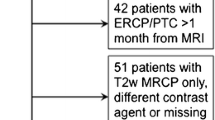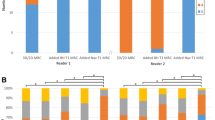Abstract
Objective
Biliary strictures after liver transplantation are common. We aimed to compare different magnetic resonance cholangiopancreatography (MRCP) sequences with regard to their diagnostic accuracy in depicting anastomotic stenoses (AST), ischaemic-type biliary lesions (ITBL) and cholelithiasis.
Methods
In patients with clinically suspected biliary obstruction after liver transplantation, MRCP was performed at 1.5 T using two-dimensional (2D) single-shot RARE, 2D T2-weighted (T2w) HASTE, 2D TrueFISP and 3D T2w TSE RESTORE sequences. The presence and localisation of lesions were assessed for each sequence independently and all sequences together. Endoscopic retrograde cholangiopancreatography (ERCP) served as the “gold standard”.
Results
Biliary strictures were detected with a sensitivity of 96% by MRCP and most accurately depicted when all sequences were analysed together. AST was visualised with highest sensitivity on TrueFISP and 3D T2w TSE sequences (79%). For ITBL highest sensitivity was found with the HASTE sequence (81%). Highest sensitivity for filling defects was revealed by the 3D T2w TSE sequence (54%). Receiver operating characteristic (ROC) curve/area under the curve (AUC) analysis revealed the best results for the 3D T2w TSE sequence.
Conclusion
Our results underline the value of different MRCP sequence types for the depiction of biliary lesions. A clinical protocol consisting of different sequences may be helpful depending on the clinical question and the likely underlying abnormality.





Similar content being viewed by others
References
Verdonk RC, Buis CI, Porte RJ, Haagsma EB (2006) Biliary complications after liver transplantation: a review. Scand J Gastroenterol Suppl:89–101
Pascher A, Neuhaus P (2005) Bile duct complications after liver transplantation. Transpl Int 18:627–642
Gopal DV, Pfau PR, Lucey MR (2003) Endoscopic management of biliary complications after orthotopic liver transplantation. Curr Treat Options Gastroenterol 6:509–515
Zhu ZJ, Rao W, Sun JS, Cai JZ, Deng YL, Zheng H, Zhang YM, Jiang WT, Zhang JJ, Gao W, Shen ZY (2008) Liver retransplantation for ischemic-type biliary lesions after orthotopic liver transplantation: a clinical report of 66 cases. Hepatobiliary Pancreat Dis Int 7:471–475
Bilbao MK, Dotter CT, Lee TG, Katon RM (1976) Complications of endoscopic retrograde cholangiopancreatography (ERCP). A study of 10,000 cases. Gastroenterology 70:314–320
Fulcher AS, Turner MA, Capps GW (1999) MR cholangiography: technical advances and clinical applications. Radiographics 19:25–41 discussion 41–24
Hintze RE, Abou-Rebyeh H, Adler A, Veltzke W, Langrehr J, Wiedenmann B, Neuhaus P (1999) [Endoscopic therapy of ischemia-type biliary lesions in patients following orthotopic liver transplantation]. Z Gastroenterol 37:13–20
Hintze RE, Adler A, Veltzke W, Abou-Rebyeh H, Felix R, Neuhaus P (1997) Endoscopic management of biliary complications after orthotopic liver transplantation. Hepatogastroenterology 44:258–262
Imanieh MH, Erjaee A, Dehghani SM, Bahador A, Malek-Hosseini SA (2009) Early postoperative complications of pediatric liver transplantation. Indian Pediatr 46:1088–1090. doi:10.1016/j.transproceed.2003.11.029
Iwamoto H, Hama K, Nakamura Y, Osamu K, Yokoyama T, Kihara Y, Ashizawa T, Niido T, Matsuno N, Nagao T (2008) Biliary complications after 52 adult living donor liver transplantations: a single-center experience. Transplant Proc 40:2539–2541
Wojcicki M, Milkiewicz P, Silva M (2008) Biliary tract complications after liver transplantation: a review. Dig Surg 25:245–257
Fulcher AS, Turner MA (1999) Orthotopic liver transplantation: evaluation with MR cholangiography. Radiology 211:715–722
Kaltenthaler E, Walters S, Chilcott J, Blakeborough A, Vergel Y, Thomas S (2006) MRCP compared to diagnostic ERCP for diagnosis when biliary obstruction is suspected: a systematic review. BMC Med Imaging 6:9
Lomas DJ, Bearcroft PW, Gimson AE (1999) MR cholangiopancreatography: prospective comparison of a breath-hold 2D projection technique with diagnostic ERCP. Eur Radiol 9:1411–1417
Taylor AC, Little AF, Hennessy OF, Banting SW, Smith PJ, Desmond PV (2002) Prospective assessment of magnetic resonance cholangiopancreatography for noninvasive imaging of the biliary tree. Gastrointest Endosc 55:17–22
Nandalur KR, Hussain HK, Weadock WJ, Wamsteker EJ, Johnson TD, Khan AS, D’Amico AR, Ford MK, Nandalur SR, Chenevert TL (2008) Possible biliary disease: diagnostic performance of high-spatial-resolution isotropic 3D T2-weighted MRCP. Radiology 249:883–890
Park DH, Kim MH, Lee SS, Lee SK, Kim KP, Han JM, Kim SY, Song MH, Seo DW, Kim AY, Kim TK, Min YI (2004) Accuracy of magnetic resonance cholangiopancreatography for locating hepatolithiasis and detecting accompanying biliary strictures. Endoscopy 36:987–992
Hekimoglu K, Ustundag Y, Dusak A, Erdem Z, Karademir B, Aydemir S, Gundogdu S (2008) MRCP vs. ERCP in the evaluation of biliary pathologies: review of current literature. J Dig Dis 9:162–169
Schmidt S, Chevallier P, Novellas S, Gelsi E, Vanbiervliet G, Tran A, Schnyder P, Bruneton JN (2007) Choledocholithiasis: repetitive thick-slab single-shot projection magnetic resonance cholangiopancreaticography versus endoscopic ultrasonography. Eur Radiol 17:241–250
McMahon CJ (2008) The relative roles of magnetic resonance cholangiopancreatography (MRCP) and endoscopic ultrasound in diagnosis of common bile duct calculi: a critically appraised topic. Abdom Imaging 33:6–9
Franco J (2005) Biliary complications in liver transplant recipients. Curr Gastroenterol Rep 7:160–164
Gor NV, Levy RM, Ahn J, Kogan D, Dodson SF, Cohen SM (2008) Biliary cast syndrome following liver transplantation: Predictive factors and clinical outcomes. Liver Transpl 14:1466–1472
Kim JY, Lee JM, Han JK, Kim SH, Lee JY, Choi JY, Kim SJ, Kim HJ, Kim KH, Choi BI (2007) Contrast-enhanced MRI combined with MR cholangiopancreatography for the evaluation of patients with biliary strictures: differentiation of malignant from benign bile duct strictures. J Magn Reson Imaging 26:304–312
Ichikawa T, Nitatori T, Hachiya J, Mizutani Y (1996) Breath-held MR cholangiopancreatography with half-averaged single shot hybrid rapid acquisition with relaxation enhancement sequence: comparison of fast GRE and SE sequences. J Comput Assist Tomogr 20:798–802
Irie H, Honda H, Tajima T, Kuroiwa T, Yoshimitsu K, Makisumi K, Masuda K (1998) Optimal MR cholangiopancreatographic sequence and its clinical application. Radiology 206:379–387
Reinhold C, Bret PM (1996) Current status of MR cholangiopancreatography. AJR Am J Roentgenol 166:1285–1295
Author information
Authors and Affiliations
Corresponding author
Rights and permissions
About this article
Cite this article
Kinner, S., Dechêne, A., Ladd, S.C. et al. Comparison of different MRCP techniques for the depiction of biliary complications after liver transplantation. Eur Radiol 20, 1749–1756 (2010). https://doi.org/10.1007/s00330-010-1714-x
Received:
Revised:
Accepted:
Published:
Issue Date:
DOI: https://doi.org/10.1007/s00330-010-1714-x




